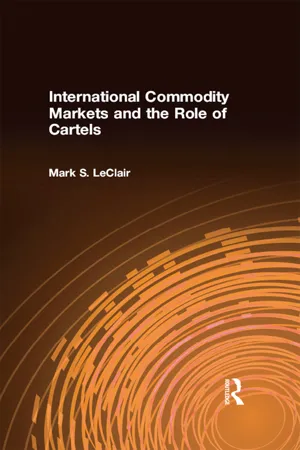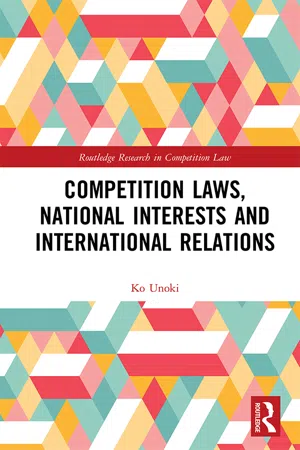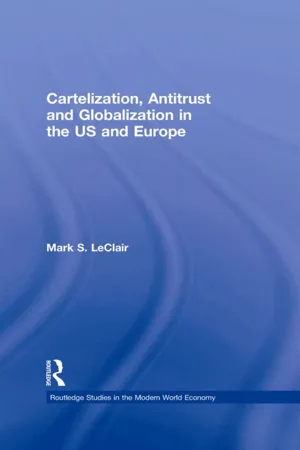Cartels
Cartels are groups of independent businesses that join together to regulate the production, pricing, and marketing of a particular product or service. They aim to reduce competition and increase their collective profits by setting prices and output levels. Cartels are often illegal and can lead to market inefficiencies and consumer harm due to their ability to manipulate prices and restrict supply.
5 Key excerpts on "Cartels"
- Mark S. LeClair(Author)
- 2016(Publication Date)
- Routledge(Publisher)
...1 International Commodity Markets and the Rise of Cartels History has shown that cartelization can occur within any market where production is confined to a limited number of suppliers. Prior to the stricter enforcement of antitrust legislation in the industrialized world, corporations from the United States, Europe, and Canada regarded Cartels as a reasonable means of increasing profitability in competitive international markets. Even after collusion became explicitly illegal, firms still engaged in the practice if the risks of getting caught were thought to be sufficiently low. Such was the case with the electrical transformer industry, which was briefly cartelized in the 1950s. Similarly, three executives of the Archer Daniels Midland Company (including the executive vice president) engaged in ongoing price-fixing of their food products during the 1980s, a practice that eventually caught up with them when they were prosecuted by the U.S. Department of Justice in 1998. In contrast to these examples, however, the majority of Cartels involve producers of commodity products, notably raw materials and high-return agricultural goods. The structure of international trade within these markets results in a strong interest in collusive agreements as a means of controlling prices. Production of many key commodities—including bauxite, cocoa, coffee, petroleum, rubber, and tin—is centered in the developing world, where legal barriers to the formation of Cartels are either weak or nonexistent. Moreover, the economies of these producing nations are often dependent on foreign sales of only one or two commodities, a factor that creates an additional incentive to forge collusive arrangements as a means of maintaining prices. The current pattern of commodity trade is largely the result of the combined effects of colonialism and the center-periphery relationship between developed and developing nations...
- Ko Unoki(Author)
- 2019(Publication Date)
- Routledge(Publisher)
...Cartels behave as they do, that is, pursue collective monopoly power, because doing so will ensure their survival and, as the ancient Athenians told the hapless people of Melos before they were to be conquered, because they could. For Cartels, a condition of unrestricted, free for all “competition” is an anathema. In a situation where Cartels are allowed to pursue a monopoly position, the Swedish economist Gustav Cassel predicted that through their anticompetitive activities, Cartels and other monopolistic forces will obstruct “the world from moving to better occupations,” with the result that industry will find “it difficult to maintain itself,” and labor will face unemployment. 18 Globalization and Cartels The concept of a cartel as elaborated in the above laws have been in existence since the rise of commercial activity in ancient times. 19 There are examples of Cartels from medieval Europe while in Japan the kabu-nakama or trade associations of the Tokugawa period (1603–1867) were also arguably Cartels that restricted membership and regulated business among its members. 20 Some business historians state the first modern Cartels to have materialized after the 1870s, partly as a reaction to a global economic turndown that was occurring at the time. 21 In Japan, Cartels appeared in 1880 with the formation of the Japan Paper Manufacturers Federation, and the Japanese Cotton Spinning Federation in 1882...
- eBook - ePub
- J. McMillan(Author)
- 2013(Publication Date)
- Taylor & Francis(Publisher)
...First, the repeated game has many equilibria other than cartel outcomes. The industry must somehow find its way to an outcome on the profit-possibility frontier. Second, there are many outcomes on the profit-possibility frontier, each with a different distributions of profits among the cartel members. The successful cartel must somehow resolve conflicts among its members over market shares. 6.2 International Cartels in practise International Cartels are usually initiated by explicit negotiations among the producers. The cartel arrangements range from loosely defined agreements to restrict output to formal arrangements providing centralized machinery for allocating output quotas and fixing prices, imposing fines on members who deviate from their quotas. Some have only a slight or short-lived effect on market prices. Others succeed in eliminating all competition among the members. A common way in which a cartel controls sales is by a geographical division of the world market. Each producer is free to set its own price and output within its own geographical area, but may not, according to the terms of the cartel agreement, sell in other members’ areas. In other Cartels, members sell worldwide but sell no more than a preassigned amount at a preassigned price. More rarely, a cartel may have a central sales organization which pools orders and allocates them across members. The following data are drawn from a survey of the econometric and anecdotal literature on international Cartels by Eckbo [ 41 ], Chapter 3. This evidence covers 51 cartel agreements in 18 industries, the earliest agreement being in 1819 and the latest in 1964. A test of the success of the cartel is whether it achieved a price close to the monopoly price. In the absence of detailed data on cost and demand functions, Eckbo defined a cartel as being successful if it raised the price to at least three times the marginal production cost of the highest-cost cartel member...
- Mark S. LeClair(Author)
- 2012(Publication Date)
- Routledge(Publisher)
...2 Oligopoly markets, collusion, and the operation of Cartels The manipulation of market prices through collusive agreements dates back to the beginning of industrialization. During the period from the1890s to roughly 1950, lax enforcement of antitrust laws essentially per- mitted Cartels to operate, and collusion was common and relatively trans- parent, particularly in commodity markets. From the mid-1960s to the mid-1980s, the United Nations and its agencies encouraged developing nations to adopt commodity price agreements that circumvented the legal constraints imposed by the industrialized nations. In contrast to the extra- legal model common to the developing world, collusion in the United States and Western Europe since 1950 has been driven underground by the threat of legal sanctions. The means by which Cartels fix prices differs con- siderably from one period to the next. Cartels that operate in the open can utilize many mechanisms to affect prices, whereas Cartels that function clandestinely are constrained by antitrust laws and thereby rely on fewer methods to manipulate markets. This chapter will examine the theoretical basis for the pricing structures utilized by Cartels within the context of the periods noted above (see Table 2.1 for an illustration of the periods and characteristics of Cartels). In markets that are free from antitrust regu- lations, price manipulations can take the form of buffer stocks, central selling points, export controls, and straightforward pricing agreements (as in bid-rigging). Conversely, in countries that abide by antitrust laws, price-fixing—whether it takes the form of a verbal agreement or a more formal arrangement—is the only option for collusion...
- eBook - ePub
The Evolution of Modern Capitalism (Routledge Revivals)
A Study of Machine Production
- J. A. Hobson(Author)
- 2013(Publication Date)
- Routledge(Publisher)
...Legally the difference no doubt is large, for whereas the Trust generally assumes the form of a publicly authorised corporate body (though the legality of particular forms may be contested), the partial or temporal combinations are in almost every instance extralegal or actually illegal. A half-way house between the informal combinations we have been considering and the “Trust,” or other complete amalgamation, is the “Cartel,” as found in Germany, Austria, Belgium, and other Continental European countries. Though their progeners may be traced far back in Dutch and German industrial history, their present shape and importance are quite modern. Extending the idea of the Industrial Pool, the businesses adopting the Cartel have formed themselves into public corporations for the purpose of fixing uniform selling prices and regulating output, but without assuming a direct control management over the syndicated businesses or a uniform rate of profit. § 2. The best organised of these Cartels are in the coal and coke industries, and in the pig-iron, steel, and manufactured metal trades of Germany and Austria. The structure of the Cartel and its mode of operation is best illustrated in the important Coal Cartel of the Ruhr in Rhenish Westphalia. The mineowners of the district form a selling company (with a nominal capital, the shares of which they hold), designed to act as their sole agent for the sale of their coal. This company, or syndicate, is organised in statutory form, as a corporation (Actiengesellschaft)...




